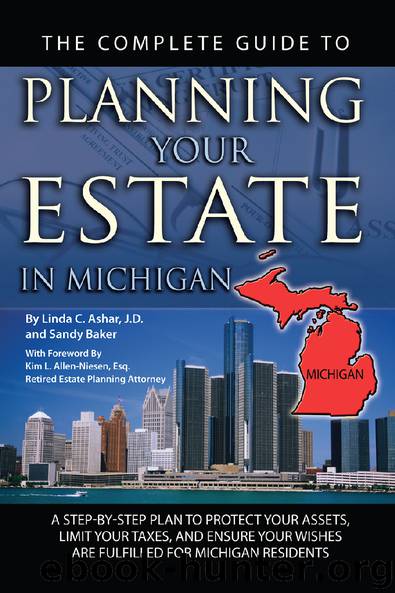The Complete Guide to Planning Your Estate In Michigan: A Step-By-Step Plan to Protect Your Assets, Limit Your Taxes, and Ensure Your Wishes Are Fulfilled for Michigan Residents by Linda C. Ashar

Author:Linda C. Ashar
Language: eng
Format: epub
Tags: estate, will, trust, assets, estate planning, disability, costs, taxes, legal costs, Michigan, living will, power of attorney, executors, trustees, insurance
Publisher: Atlantic Publishing Group
Published: 2013-03-06T00:00:00+00:00
Making Your Trust Valid
One of the most important things for you to consider about a trust is whether the trust is valid. In the wording and the structure of the trust, you will need to set up and maintain this aspect. Again, working with your attorney is a must, for this reason alone. You should understand how a trust is set up so that it is valid and will do what you wish it to do.
Step 1: Preparing the documents
First, do not be fooled into thinking that there is a “one way is the only way” philosophy when it comes to creating a living trust document. The fact is, there is no legal form that must be used. Working with your attorney, you can create a simple form that includes what the document is and defines all the terms of the trust. All the important individuals that we have talked about, from the trustor and the successor trustee, down to the beneficiaries, need to be spelled out. You need to identify all your property in the trust and where it will go (and how) to your beneficiaries. Although no witnesses are required, you should have it notarized, which means signing the trust in front of a notary. It is imperative that you do have it notarized, rather than using bank guarantees or other options, as it is only official once it has been notarized.
Step 2: Transferring to the trustee
Next, you need to transfer the trust property into the trustee’s name. If you do not make this formal step, the successor trustee will not be able to perform his or her duties to the fullest. What this means is simply assigning your name to all documents in a specific format. It should read, “John Doe, as trustee for John Doe Trust” on the documents.
The property that will be placed into your trust that has a title or otherwise has legal paperwork that shows its ownership is the first type of property to make this change with. This includes your real estate; bank accounts; vehicles; safe deposit boxes; stocks and bonds; partnerships, including corporations and limited partnerships; mutual funds; and money market accounts. All these have a title or ownership papers that need to be transferred into the trustee’s name as we have described.
Some property does not have any such documentation for ownership. Your jewelry, household items, clothing, cash, and any other type of valuable property that you will be placing into your trust without documentation for ownership still need some additional note. To transfer these items into the trustee’s name, you will simply include them in a list format on your paperwork with a “Notice of Assignment” listed with them, which simply transfers ownership.
Step 3: Maintaining your trust over time
Just setting up your trust is not enough to keep it going. The trust is unique from most other forms of wills and substitutions because at any time, it can be revoked or otherwise changed to fit what is happening now in your life.
Download
This site does not store any files on its server. We only index and link to content provided by other sites. Please contact the content providers to delete copyright contents if any and email us, we'll remove relevant links or contents immediately.
The Social Psychology of Inequality by Unknown(2771)
The Plant Paradox by Dr. Steven R. Gundry M.D(2435)
The Writing on the Wall by Anselm Jappe(1973)
Working for Yourself by J.D. (Nolo) Stephen Fishman(1737)
Every Landlord's Legal Guide by Janet Portman & Stewart Marcia & Ralph Warner(1568)
The First 20 Hours: How to Learn Anything ... Fast by Kaufman Josh(1560)
ADHD on Trial by Michael Gordon(1476)
Decisive by Chip Heath(1458)
Working for Yourself by Stephen Fishman J.D. (Nolo)(1420)
Drafting Contracts: How and Why Lawyers Do What They Do, Second Edition by Stark Tina L(1404)
A Practical Guide to International Arbitration in London by Hilary Heilbron(1348)
The Economist Aug 8th 2015 by The Economist(1344)
Restitution by Restitution(1332)
The Lord of the Rings: The Fellowship of the Ring, the Two Towers, the Return of the King by J. R. R. Tolkien(1322)
Intellectual Property Strategy by John Palfrey(1319)
The Economist Aug 29th 2015 by The Economist(1303)
Collusion by Luke Harding(1247)
Persuasion by Owner(1227)
The New Whistleblower's Handbook by Stephen Kohn(1144)
